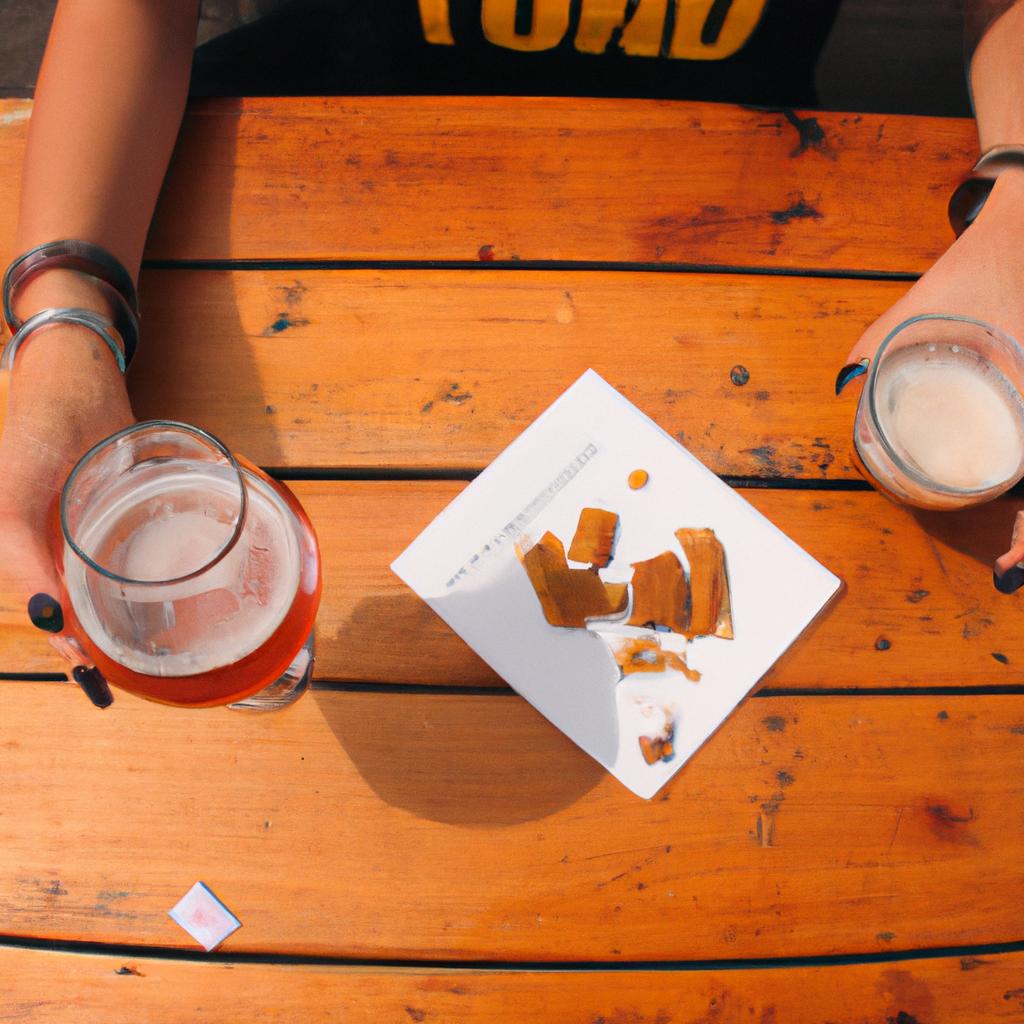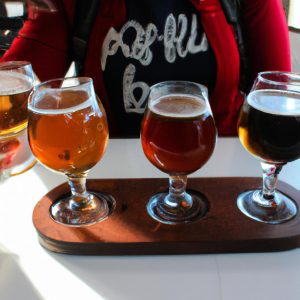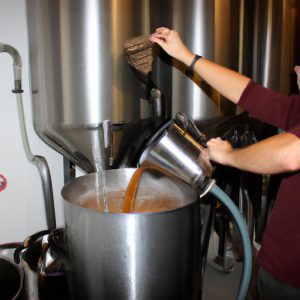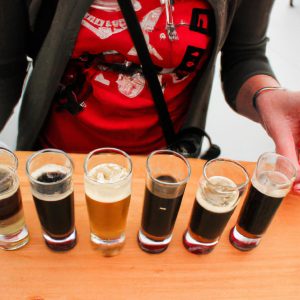Food Pairings in Craft Beer Reviews: The Perfect Combinations

Food pairings have long been a subject of interest and exploration among beverage enthusiasts, particularly in the realm of craft beer. The art of pairing food with specific beers has gained significant attention as it enhances the overall tasting experience by complementing or contrasting flavors. For instance, imagine indulging in a rich and robust stout alongside a decadent chocolate cake; the combination creates a harmonious balance that elevates both the beer and dessert to new heights. This article aims to delve deeper into the world of food pairings in craft beer reviews, exploring how certain combinations can bring out the best qualities in each component.
Pairing beer with food is not simply about matching similar flavors together but rather understanding how different elements interact on our palates. Each beer possesses its own unique characteristics such as bitterness, sweetness, acidity, and carbonation levels that can be enhanced or subdued when paired correctly. By carefully selecting complementary or contrasting flavors from various ingredients found in dishes, one can create an extraordinary dining experience where each bite and sip work synergistically to elevate taste sensations. Consequently, this article will explore some notable examples of successful food pairings with craft beers while also providing insights into why these combinations work so well together.
Understanding the principles behind effective food pairings can greatly enhance one ‘s ability to create memorable dining experiences. When pairing craft beer with food, it’s important to consider the following principles:
-
Complementing flavors: Pairing a beer that complements the flavors of a dish can enhance both the beverage and the food. For example, a hoppy IPA can complement spicy foods by providing a refreshing contrast to the heat.
-
Contrasting flavors: Sometimes, contrasting flavors can create an exciting and harmonious balance. A tart and fruity sour beer can cut through rich and fatty dishes, creating a refreshing contrast that cleanses the palate.
-
Balancing intensities: It’s essential to consider the intensity of both the beer and the food when pairing them together. A bold and flavorful beer may overpower delicate dishes, while a light-bodied beer might get lost when paired with heavy or strongly flavored foods.
-
Regional pairings: Exploring traditional regional pairings can be a great starting point for discovering complementary flavors. For instance, pairing Belgian-style beers with Belgian waffles or German lagers with sausages and pretzels can create authentic taste experiences.
-
Experimentation: Don’t be afraid to experiment! The world of craft beer offers endless possibilities for pairing with various cuisines and ingredients. Try different combinations to find unexpected flavor profiles that work well together.
By understanding these principles and experimenting with different pairings, you can create delightful culinary experiences where craft beer enhances the overall enjoyment of your meals. Remember, there are no strict rules when it comes to food pairings – it ultimately comes down to personal preferences and finding what works best for your taste buds!
Understanding the Basics of Food Pairings
Imagine sitting down to a sumptuous meal at your favorite restaurant. The waiter approaches you, asking if you would like any recommendations for craft beers to complement your food choices. Intrigued, you decide to explore this new territory and embark on a journey of discovering the perfect combinations between food and craft beer.
To truly understand the art of food pairings in craft beer reviews, it is essential to grasp the basics. At its core, food pairing involves finding flavors that harmonize or contrast with each other, enhancing both the culinary experience and enjoyment of the beverage. Just as a perfectly paired wine can elevate a dish, so too can a well-matched craft beer enhance the flavors on your plate.
When considering food pairings in craft beer reviews, several factors come into play:
-
Intensity: Matching intensities ensures that neither the food nor the beer overpowers one another. A light-bodied lager may be best suited for delicate seafood dishes, while robust stouts could stand up well against rich chocolate desserts.
-
Complementary Flavors: Seek out flavors that work together harmoniously. For instance, hoppy IPAs often highlight citrusy notes that beautifully complement spicy foods or tangy cheeses.
-
Contrasting Elements: Sometimes opposites attract! Combining contrasting flavors can create an interesting sensory experience. Think about how a crisp pilsner’s refreshing bitterness cuts through fatty meats or creamy sauces.
-
Regional Pairings: Exploring regional cuisines alongside local craft beers allows you to celebrate cultural traditions while experiencing unique flavor profiles specific to certain geographic areas.
In order to better illustrate these principles, consider this hypothetical example showcasing different types of cuisine and their recommended craft beer pairings:
| Cuisine | Dish | Recommended Craft Beer |
|---|---|---|
| Mexican | Spicy Chicken Tacos | Citrus-infused IPA |
| Italian | Margherita Pizza | Light-bodied Pale Ale |
| Thai | Green Curry | Wheat Beer |
| American BBQ | Pulled Pork Sandwich | Smoky Porter |
By thoughtfully combining flavors, such as the zesty notes of an IPA with spicy chicken tacos or the roasted maltiness of a porter with tangy barbecue sauce, you can create a truly memorable dining experience.
Understanding the basics of food pairings in craft beer reviews allows us to delve deeper into exploring flavor profiles in these beverages. In the following section, we will uncover the intricate relationship between different craft beers and their unique characteristics that contribute to successful food pairings.
Exploring Flavor Profiles in Craft Beers
Imagine sitting down to enjoy a pint of craft beer after a long day, but something is missing. That’s where food pairings come in. When done right, pairing the right foods with your favorite brews can elevate both the taste and experience. In this section, we will delve into the basics of food pairings, exploring how different flavors interact and complement each other.
To illustrate the power of food pairings, let’s consider an example: a rich and creamy chocolate stout paired with a slice of decadent chocolate cake. The velvety texture and roasted notes of the stout perfectly complement the indulgent sweetness of the chocolate cake, creating a harmonious balance that enhances both elements. This case study exemplifies how deliberate combinations can elevate our enjoyment of craft beer.
When it comes to crafting successful food pairings, there are several key factors to keep in mind:
- Flavor Profiles: Understanding the flavor profiles of both the beer and the food is crucial. Consider whether you want complementary or contrasting flavors.
- Intensity: Balancing intensity is important; neither element should overpower or overshadow the other.
- Texture: Pay attention to textures when pairing food with beer – smooth beers may work well with creamy dishes while crisp beers may be better suited for lighter fare.
- Regional Pairings: Exploring regional cuisines that traditionally accompany certain styles of beer can provide insight into classic combinations worth trying.
Now let’s visualize some common flavor components found in craft beers using this table:
| Craft Beer Flavors | Examples |
|---|---|
| Hops | Citrusy, Piney, Floral |
| Malt | Caramel, Toasted Bread |
| Yeast | Fruity, Spicy |
| Adjuncts/Additional Ingredients | Chocolate, Coffee |
By understanding these flavor components and their interactions within various beer styles, you can start building informed connections between specific foods and craft beers. The possibilities are endless, whether it’s pairing a hop-forward IPA with spicy buffalo wings or a fruity wheat beer with tangy ceviche.
So let’s dive in and discover the perfect combinations that will take your craft beer experience to new heights.
Popular Food Pairings with IPAs
Exploring Flavor Profiles in Craft Beers: A Journey Through the Palate
To truly appreciate craft beers, one must delve into the intricate world of flavor profiles. Each beer style boasts its unique combination of aromas and tastes, making it an exciting adventure for enthusiasts to explore. Understanding these flavor profiles is crucial when it comes to finding the perfect food pairings that enhance both the beer and culinary experience.
For instance, let’s consider a hypothetical case study involving a citrusy American Pale Ale (APA). This APA exhibits vibrant notes of grapefruit and pine, with a crisp bitterness that lingers on the palate. To complement this profile, we can choose dishes that bring out these flavors while providing balance. Grilled shrimp skewers marinated in lemon zest and herbs would elevate the citrusy character of the APA, creating a harmonious pairing between zesty seafood and hoppy goodness.
When it comes to selecting suitable food pairings for craft beers, several key factors come into play:
- Intensity: Consider whether the flavors in both the beer and dish are subtle or bold. Combining two intense components might overwhelm the taste buds, while opting for mild accompaniments may result in underwhelming experiences.
- Complementing or contrasting: Decide if you want your chosen dish to either accentuate similar flavors present in the beer (complement) or provide contrast by introducing new elements altogether.
- Texture: Take note of how different textures interact with each other. Lighter-bodied beers often work well with delicate dishes, whereas fuller-bodied brews stand up better against heartier fare.
- Regional influences: Explore traditional cuisine from regions where specific beer styles originate. Local delicacies often have centuries-old pairings that showcase regional harmony between food and drink.
| Beer Style | Recommended Dish | Flavors Enhanced |
|---|---|---|
| Witbier | Belgian-style mussels | Citrus, coriander |
| Stout | Chocolate brownie | Roasted malt, dark chocolate |
| Saison | Grilled farmhouse chicken | Peppery spice, herbaceousness |
Understanding these factors and experimenting with different combinations can lead to delightful discoveries. By thoughtfully pairing craft beers with appropriate dishes, enthusiasts can elevate their tasting experience and unlock new dimensions of flavor.
Transitioning into the subsequent section about “Discovering the Perfect Matches with Stouts,” we continue our exploration of how various beer styles interact with food. Through this journey, we will unveil the exquisite harmony that awaits when stouts are paired with culinary delights.
Discovering the Perfect Matches with Stouts
Popular Food Pairings with IPAs have been widely explored and enjoyed by craft beer enthusiasts. However, there is another category of beers that offers a whole new realm of taste experiences when paired with food: stouts. With their rich flavors, deep colors, and velvety textures, stouts provide the perfect canvas for culinary creativity. Let’s dive into the world of stout beer pairings and discover some exceptional combinations.
Imagine indulging in a decadent chocolate dessert while sipping on a robust imperial stout. The bittersweet notes from the dark chocolate beautifully complement the roasted malt characteristics of the stout, creating an exquisite harmony on your palate. This classic combination showcases how stouts can enhance the flavors of rich desserts and create a truly memorable dining experience.
To further explore the potential of pairing stouts with various foods, consider these key points:
- Contrasting Textures: Stouts’ creamy mouthfeel can be wonderfully balanced by crunchy or crispy elements in dishes like fried chicken or bacon-wrapped scallops.
- Complementary Flavors: Fruity stouts infused with hints of berries or cherries are often elevated when paired with tangy cheeses such as blue cheese or goat cheese.
- Collaborative Ingredients: Incorporating shared ingredients between the dish and the stout can create harmonious flavor profiles. For example, adding coffee to both a chocolate cake recipe and a coffee-infused stout can intensify those complementary flavors.
- Regional Influences: Exploring local cuisines alongside regional stout varieties allows you to appreciate unique cultural fusions. Think about trying oysters paired with an Irish dry stout or spicy barbecue ribs alongside a smoky Russian imperial stout.
In addition to these insights, let’s take a look at a table showcasing different types of stouts and their suggested food pairings:
| Stout Type | Suggested Food Pairing |
|---|---|
| Milk Stout | Chocolate truffles |
| Oatmeal Stout | Grilled steak |
| Coffee Stout | Espresso-rubbed pork ribs |
| Imperial Stout | Roquefort cheese |
By combining the textural, flavor, and regional considerations mentioned above, you can create an immersive dining experience that tantalizes both the taste buds and the imagination.
As we delve into unexpected combinations in the next section, exploring how sour beers can pleasantly surprise our palates when paired with food, let’s continue to embrace the art of craft beer pairing. Understanding the intricate interplay between different flavors will allow us to unlock extraordinary gastronomic adventures that go beyond what meets the eye or tongue.
Unexpected Combinations: Sour Beers and Food
As we delve deeper into the realm of craft beer and food pairings, stouts emerge as a distinct category that offers unique flavor profiles to explore. These rich and robust beers can enhance the dining experience when paired thoughtfully with complementary dishes. To illustrate this point, let’s consider an example: imagine savoring a velvety chocolate stout alongside a slice of decadent flourless chocolate cake. The combination of deep cocoa flavors in both the beer and dessert creates a harmonious symphony on your palate.
When it comes to pairing stouts with food, certain guidelines can help you navigate through the complex world of flavors. Consider the following points:
-
Complement or contrast: Just like any successful pairing, stouts can be matched with foods that either complement or contrast their characteristics. Complementary pairings aim to bring out similar flavors in both the beverage and dish, such as pairing a coffee stout with a mocha cheesecake. On the other hand, contrasting pairings create balance by combining opposing tastes; for instance, serving a rich imperial stout with tangy barbecue ribs.
-
Intensity matters: When selecting foods to accompany stouts, it is important to consider intensity levels. Full-bodied stouts go well with hearty dishes like grilled steaks or smoked meats, while lighter versions may work better with delicate desserts or seafood options.
-
Seek balance: Achieving balance between the beer and food components is crucial for a successful pairing. A heavily hopped stout could overpower subtle flavors in certain dishes, so opt for more assertive cuisines like spicy Mexican or Indian fare to match its boldness.
-
Experimentation is key: While there are general guidelines for pairing stouts with specific types of food, don’t be afraid to experiment and trust your taste buds! Each person’s preferences vary, so feel free to think outside the box and discover unexpected combinations that suit your personal palate.
To further illustrate the potential of stout pairings, let’s examine a hypothetical table showcasing various stouts and their ideal food companions:
| Stout | Ideal Food Pairing |
|---|---|
| Chocolate Stout | Flourless chocolate cake |
| Coffee Stout | Mocha cheesecake |
| Imperial Stout | Tangy barbecue ribs |
| Oatmeal Stout | Dark chocolate brownies |
In conclusion to our exploration of stouts in craft beer pairings, we have seen how these rich brews can elevate dining experiences when matched with suitable dishes. Now, let us delve into tips for creating your own exciting combinations in the next section: “Tips for Creating Your Own Food and Beer Pairings.”
Tips for Creating Your Own Food and Beer Pairings
Unexpected Combinations: Sour Beers and Food
In the world of craft beer, there are often unexpected combinations that can elevate the tasting experience. One such example is pairing sour beers with food. While traditionally not as popular as other beer styles for pairing, sour beers offer a unique flavor profile that can complement certain dishes in surprising ways.
The tanginess and acidity present in sour beers create a refreshing contrast when paired with certain foods. For instance, imagine enjoying a crisp and tart Berliner Weisse alongside a plate of fresh oysters. The briny taste of the seafood enhances the complexity of the beer’s flavors, resulting in a delightful sensory experience.
To further explore the potential of sour beer and food pairings, consider these key points:
- Contrasting flavors: Sour beers possess an acidic quality that can balance out rich or fatty dishes. When paired with creamy cheeses or charcuterie boards, for example, the tartness cuts through richness to cleanse the palate.
- Enhancing aromas: Just like wine pairings, specific flavors and aromas within a meal can be enhanced by the right choice of beverage. In this case, sour beers with fruity undertones can intensify the aroma of fruit-based desserts or tropical-inspired dishes.
- Experimentation: Don’t be afraid to venture into uncharted territory! The diverse range of ingredients used in crafting sour beers allows for experimentation with various cuisines and flavors. Get creative by exploring different cultural dishes and finding unexpected harmonies between them and your chosen brews.
- Personal preference matters: Ultimately, everyone has their own tastes and preferences when it comes to food pairings. It’s important to remember that what works for one person may not work for another. Trust your instincts and let your personal enjoyment guide you in discovering new combinations.
Consider this hypothetical scenario showcasing some possible food pairings with sour beers:
| Dish | Beer |
|---|---|
| Grilled peaches | Fruited Lambic |
| Goat cheese salad | Gose |
| Spicy Thai curry | Dry-hopped Berliner Weisse |
| Citrus tart dessert | Sour IPA |
In conclusion, sour beers can offer an exciting avenue for exploring unique food pairings. By contrasting flavors, enhancing aromas, embracing experimentation, and considering personal preferences, you can uncover unexpected combinations that will elevate your craft beer tasting experience. So go ahead and venture beyond the norm – you might just discover a new favorite pairing!



